
Mirna Bamieh
Artist and culinary researcher Mirna Bamieh explores the politics of disappearance and memory production by unpacking the social concerns and limitations felt by Palestinian communities amid contemporary political dilemmas. The artist melds food, storytelling, and art, and since 2019 has investigated processes of fermentation in text, ceramics, and video works, often incorporated into site-specific interactive installations.
Luísa Santos: I first met you at HANGAR in Lisbon, during your residency in January this year. A couple of months later, I saw your talk-performance there, and was completely baffled both by the depth of your work and how you share it. You don’t call your talks “talk-performances”, but they contain elements of sharing and reciprocity in a performative way, which are unusual in traditional talks. You move while you talk, your body is fully connected to your speech, and you are genuinely willing to listen as much as to talk. The talk ended at the table, and, through this moment of gathering, you managed to get everyone moving, eating, and talking to each other as if they were all long-time friends. The orange marmalade that was at the table was, in fact, part of Bitter Things, your recent show in Spain. Can you speak about oranges and their meanings, as well as different histories and contexts, for Bitter Things?
Mirna Bamieh: My father has a bitter-orange tree in his garden; it doesn’t give many oranges – around 20 a season - but he keeps them until I come back from my travels to prepare them for his favourite marmalade. Every season, he recounts how the garden had two bitter-orange trees, and had he known that his daughter would love bitter oranges, he would never have cut the other one down. One of the reasons bitter oranges are my favourite citrus fruit – other than it being an heirloom variety, which makes it dear to me – is the fact that cities have been integrating them into their urban planning for centuries, like the Umayyads did. The trees have now fallen out of use; people have stopped planting them, or grafted them with other trees with fruit more easily eaten or processed or which are simply more palatable than the super-sour bitter oranges.
'My father is from Jaffa, the city of sweet oranges. Jaffa is not sweet anymore, and its oranges are mere tales of a glorious history that is no longer present. This history speaks to the bitter-orange story. Is a Jaffa orange a Jaffa orange if the story of its city and people have been violently tossed away? A Jaffa-labelled orange, sold in Tesco, is not a Jaffa orange.'
After the 1948 Nakba, most of the Arab-owned orange groves were taken by force by the new Israeli state. The orange-growing industry was presented as a ‘pioneering labour-movement project’, which was void of any Arab presence. Jaffa oranges, one of the symbols of Palestine, were appropriated to become a symbol of Zionism, while its people, the Palestinian orchard owners, became side characters in the story of this orange, not the main players. The city of Jaffa is the main character here; once upon a time, it was named the bride of the Mediterranean for its glory, cultural richness, and oranges.
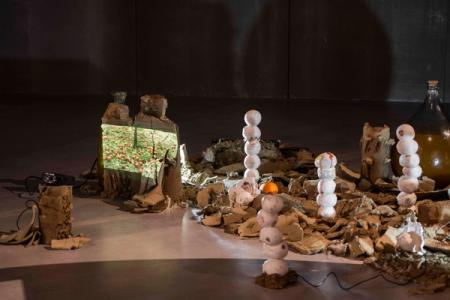
Bitter Things was inspired by the bitter-orange trees growing in front of the C3A Centre in Córdoba. It was a Thyssen Bornemisza TBA21 commission in two parts: one, in spring, around bitter oranges, and the other, in autumn, around olives. With La Fresnedilla collective in Córdoba, we processed around 300 kilos of bitter oranges from the museum’s garden into preserved juice concentrate and marmalade following three different recipes from Andalusia and Bilad al-Sham, which are traditional and labour-intensive and little used nowadays. We filmed the process from harvest to jarring and the six resulting videos were part of the final installation.
Bitter Things: In the Name of an Orange. It opened on 26 April at C3A. It was a multimedia installation of a kitchen structure, through which I wrote stories of bitter oranges from the museum’s backyard, of those from my father’s garden, and of Jaffa oranges from my family’s origin in Palestine. The story line goes from ancient times, to histories of colonization, occupation and dispossession, and how they have all seeped their way to my body, both personal and collective.
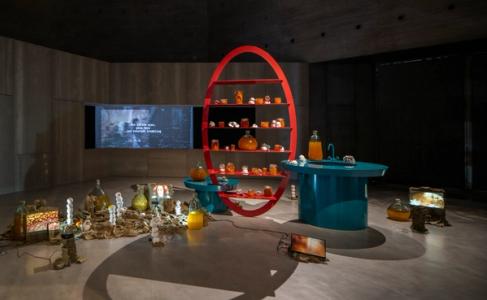
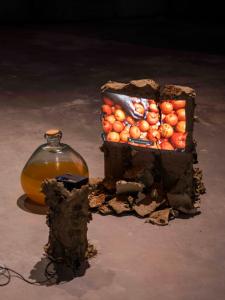
Clay landscapes spilled from the Bitter Things kitchen, expanding it like a shadow. These landscapes were a blend of natural, unfired clay, and engulfed the six videos and 22 ceramic sculptures of Jaffa oranges. These were stacked on top of each other, both holding space and on the verge of collapse. Other ceramic oranges were crushed, squashed, pressed, while others were decaying and oozing. Certain ceramic oranges incorporated archival transfers of labels of Jaffa orange orchards from before the Nakba, enriching the collection with layers of history, narrative and emotion.
Part of the Bitter Things installation was Interrupted Biographies, a video that I created in 2014 to highlight an almost forgotten period of history, when the borders between Palestine and Lebanon were porous, a period that made it possible for my mother and father to meet and start a family. It is a work about the scars that wars leave on the body, like those on my mother’s body. Interrupted Biographies gave the kitchen its soundscape, filling the space with sounds of my brother’s birthday, where the video imagery is from, and sounds of a meeting at my grandma’s house in summer 1996 when maternal family members gathered from around the globe. There is a scene in which my mother dances to pop music by Ragheb Alama, which always brings me to tears.
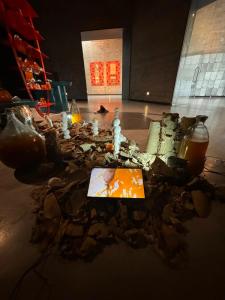
In an adjoining space, I showed two photographic prints of archival documents from 1946 addressing the losses of Palestinian farmers, and another print with two pages of a diary from 1987 by Najat Bamieh, a Jaffa resident, about her life there and the loss of their house. It is a touching testimony that weaves the city into oranges and the losses it bore with the forced exile of its inhabitants during the Nakba.
'Through this combination of media and techniques I tried to build a visual, spatial language that expanded history into materiality and so highlighted the value of the lived and the intimate.'
LS: You started your long-term project Sour Things in 2023. The first version was Sour Things: The Souq, a site-specific version in the vacant fruit and vegetable souk in Sharjah for Sharjah Biennial 15. Ideas of decay and preservation were already quite present in that first version, but I feel that is something that has grown over the lifetime of the project. The first Sour Things was situated outside, the second, Sour Things: The Kitchen, was indoors and it had these more individual and bodily elements. Would you like to share some of the ideas of decay and preservation in Sour Things, both in the more collective and individual bodies?
MB: Interesting question. My work looks intimately at domesticity and then stages it. It takes stories about the kitchen for instance and then creates dinner performances around them. These celebrations seem the opposite of the humble kitchen table. This is, of course, done intentionally as I want to put our voices and our stories – as Palestinians first, and as women second – centre stage. In my performance Palestine Hosting Society, I run the kitchen operation for the event with my team, but at dinner time, I am in the limelight. I become the performer, the carrier of those stories. I hold the mic, and all eyes are on me. It’s not a spot for an introvert for sure, but I have another side of me, one that adores solitude and seeks it for creation. That’s where fermentation and ceramics come into play, where slowing down, contemplation, reflection, technicality, and mastery takes place, and where the writing happens.
'They are different modes of production, happening in between the different personalities and bodies inside me – my story as a Palestinian is not more important than my story as Mirna the person, yet they cannot be separated. My responsibility towards myself as a creator is to give voice to all parts of me, as the individual and as the extended collective that inhabits me and my experience.'
Each part of the Sour Things series – The Kitchen; The Pantry; The Table; The Staircase; The Wall; The Bed; The Washroom; The Door; The Chair – serves as a fragment of a dwelling, a response to the specific political conditions in Palestine that have prevented me from settling and staying, rendering me nomadic for the past decade. Sour Things is a total work, a home made of models of domesticity that emerges from a period of introspection on notions of transformation, time, labour, and a slower mode of consumption. It is an approach that resides between excess and restraint, home and body. I am creating more installations for the ‘taste series’, like Bitter Things, which looks more at preservation practices of oranges and olives. There will be a moment for sweet things and other taste-related material reflections and creations in the coming year. I do find comfort in creating umbrella bodies of work that have several iterations or productions underneath it; Palestine Hosting Society is one example, Potato Talks is another.

As for why fermentation – every installation gives a new and different answer. It is a journey. I offer you an excerpt from a text I wrote in 2020, entitled ‘Cultivating Wisdom, Becoming Others’: ‘…It is said that experience becomes banal and insignificant, unless it is turned into wisdom. When I heard that, I felt my body was a battlefield of experiences that never seemed to have amounted to anything; it was the thing that would make me less tormented, less confused, less preoccupied, less entitled, less extreme, less alone, the thing that makes me more grounded, more responsible, more oriented, more caring, more of water and earth, less of air and fire.
‘To be wise, is to be able to take a step away from matters, and be able to inhabit different perspectives away from your interest point. To be wise is to keep practising wisdom, to recultivate that basic synchronicity with nature and the natural.
‘I am not really wise. Yet, the only wisdom that comes to me naturally is through watching time work its way on ferments. A deliberate constant practice in my ever-shifting life. To cultivate that wisdom, I stretch my relationship to food in all directions. One way to stretch it, is through metaphor, with fermentation as a process for reflections: the way time transforms in the jar; how mothers are the true beginnings; how cultures move in waves; how change flows; how decay is not an end; how rot is a state; how freshness is a transition.
‘Another way for that stretch is to void fermentation of metaphor, uprooting it from empathy, understanding it purely for what it is, rejecting presumptions of human dominance, humbly understanding that it is a tangled web of relations, and we are collaborators. Realizing that these cultures preceded us on Earth, that our survival depends on them, without them we would not exist.’’
‘In that precarious distance, and in between the actual and the metaphorical, is where wisdom sprouts. The wise steps down from the high position of teacher, philosopher, prophet, and communicate from eye level, becoming a mother, a visionary, a fighter.You made me, I eat you. you live through me, I am your borders. I become you, we thrive. You eat me; we transform. We become others.’
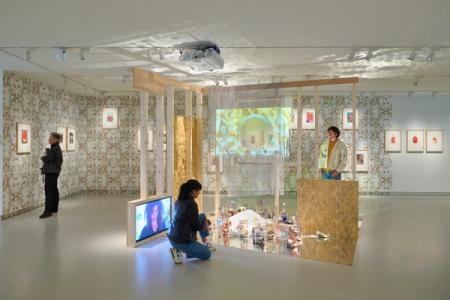
LS: In Sour Things: The Pantry, the elements that struck me most in this work were the turtles, these bodies with different, all quite painful, expressions, carrying salt, which you say represents ‘hope’ and ‘the future’. This tension between pain and the present and hope and the future can be found in the wallpaper as well. At first sight, it looks like this beautiful image, a colourful pattern, but on closer inspection, we see decaying lemons and painful faces. This contrasts with the drawings on the wall, which are all very painful. You made the drawings in your residency at HANGAR, after a talk with a girl from Palestine, right?
MB: The Pantry piece was born and fully created during the war, turned genocide in Gaza. I was invited by Nina Folkersma to show one of the Sour Things series at Image Home, a show at the Het Noordbrabants Museum in the Netherlands. We started talking about my participation in September 2023 and were discussing the Kitchen piece. I was in New York then, but less than a month later, in early October, I went to Palestine to see my family. It felt like I woke up from the jet lag to a reality whose pace and scale I couldn’t grasp. Everything in Ramallah started to move between shock, pain, and unpredictability. Creation-wise, making this piece required the least creative intervention from my brain of any I’ve done; it was mostly a gut piece. As artists, we construct and deconstruct thoughts and images and sketches while working on a new piece; it’s a constant creative editing in and out, of addition and omission. With the Pantry piece, I just allowed myself to flow with it, not because of a conscious decision, but out of exhaustion. My whole being was exhausted; I had no energy to fight the flow, and the flow didn’t stop. That didn’t mean it wasn’t changing – it was, all the time – but I was just letting it do its own thing, and my part was labouring to make it material.
In mid-October, I told the curator that I would like work on a pantry space for the uprooted, and the museum immediately commissioned the piece. By the end of October, I left my kitchen, my pantry space, and found myself uprooting myself. It does look like a choice, but I think that politics dictated that decision, just like it did to the characters in Interrupted Biographies. Nina is a very caring curator, and she accompanied and accommodated me; she accepted the labour of constructing and demolishing the pantry space with me. For instance, I would see the space in my head before I went to sleep, only to wake up and see it crumbled and no longer serving. I spent a week like that until I was able to find a liminal design of being and non-being, of a space and no-space. A pantry space that was a shadow, a mixture of a present that is not there, and a past that doesn’t go away.
As I said, the images were coming from my guts, and I was just rendering the material. The videos of the pantry are another example. I saw myself arranging archeological pottery pieces collected by an ex-lover of mine who was deep into researching old spring wells in Palestine, and who would find and collect these pieces. Before he emigrated he gifted them to me, because, he said, I was the best person to care for them. I saw images of me arranging those pieces on the landscape body of a man. That was the last moving image I filmed before leaving Palestine: me arranging those pieces on a male body, and the other my washing them one by one.
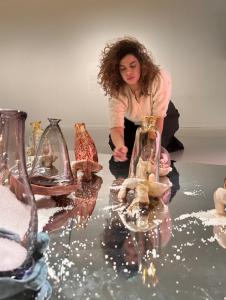

'The ceramic turtles also just emerged like clear images. They are the migrants, the survivors, the uprooted, those who have witnessed unjustifiable atrocities, yet who still move into the future, painfully on their chests.'
I made them one by one, and the extent of the pain that was materializing in their bodies from voided bellies, amputated wombs, scratched, and deformed guts would render me speechless at times, and at others would bring me to tears. Those ceramic turtle creatures were produced over a period of one month in Lisbon. I made them during the day and at night I made watercolour, ink, and brine drawings on cotton paper. The drawings also came to me with no fight. It is worth noting that my art practice started when I was 19 with drawings, a process with a free association and flow to it. Then, after three years of making intricate black-ink drawings on paper, it just left me, and I was not able to draw a proper line afterwards. It only came back in November 2023, after I opened Sour Things: The Kitchen in Dubai with NIKA Project Space. Amid all the chaos of a war happening in my homeland again, the ability to draw came back to me, I just felt it in my body. I even took the paper, inks, and paints with me from Dubai to Lisbon so I could go straight into drawing as soon as I arrived without getting distracted with the practicalities of the where and how.
A particular sentence was haunting me, written by a 13-year-old girl from Gaza that was shared on social media: “Would I be free if I were an object?” I processed it over and over in writing for 22 drawings. It was beyond my grasp or comprehension how this kind of thought could come to someone at that age.
'It is beyond brutal to have to negotiate attaining freedom by giving up on the human and residing in an object.'
In those drawings, I was trying to process that thought and the layers behind, below, and above it, through the object of a jar. Those drawings are intricate and painful, the pain was mine, of others, and it extended beyond all bodies. The Pantry’s jars were those, in the drawings, in the glass jars carried by the turtle creatures with handfuls of preservation salt, and the broken archeological vessel pieces in the videos.

LS: One work that you didn’t mention in your talk at HANGAR was the Mouneh: Pantry Work, with its Fermentation Station kitchen lab that included six booklets with unique recipes weaved into autobiographical stories, and To Jar, a short film that you also share in Sour Things: The Workshop. Mouneh, as with all your work, was the result of an intensive research period. Is it a first version of Sour Things?. While all your works are connected – as you said last time we met, ‘they are all me’ – these two bodies of work seem completely interdependent. Another thing that made me quite curious, which you’ve mentioned a few times, is the writing element. Does writing come across in your installations and overall practice, and if so, how?
MB: You are right, I don’t usually show this work in recent artist talks, although it is somehow where most things in relation to fermentation started in the years to follow. Text has been regular in my practice through several works, whether in statements that give a deeper understanding of videos like in This Mine Land, or through other people’s writing that give an important layer to seeing my images like in Story of I, and other suggestive landscapes where I needed a graphic and pornographic text to be layered with moving images across Ramallah, Jerusalem, and Tel Aviv. Or through collaborating on texts as I did with Dalia Taha on The Pessopotimist, for which she was commissioned to continue Emile Habibi’s novel written in 1974, with the same title that merges ‘optimist’ and ‘pessimist’ into one word. From the first chapter and Imagine the Pessopotimist in Ramalllah 2015, I used text in several works as instructional material that looks at the absurd and nonsensical in memory preservation, such as forgetting in A Manual How to Preserve Memory, and as instructional text in Tutorial: How to Disappear, Become an Image.
Text more or less has always been present in the core of what I do. Yet it took a totally different mode of flow and topics in 2019, when I started writing texts structured around fermentation recipes, which influenced the writing itself, whether in the text’s structure flow of events, vulnerability, observation, or mode of reflection.
'Writing for me is an intimate space of revelation, in which I connect the collective with the personal, the universal with the singular, the macro with the micro.'
I think my writing flows better when it has a bacterium-related starting point. Those texts were first shown as texts for reading at exhibitions like Mouneh, or as an interactive connections to the installation at Sharjah Biennial, or later, as soundscapes for Sour Things installations, at which I do a reading of the text, amd then invite sound composers or designers to create soundscapes for my pieces in conversation with me, such as the last two soundscapes I invited Issac Sullivan to do. Music and sound are also core components in many of my works as much as writing.
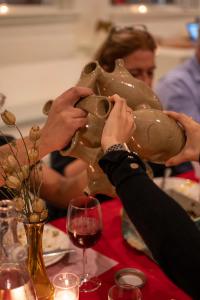
Back to Mouneh. A care work, it marked my return to installations after being fully immersed in the research and dinner performances for Palestine Hosting Society. Before Mouneh in 2021, my last installation had been (Dis)concert: A Humming Project, produced and shown in Tokyo in 2017. In 2019, I was invited by Ika Sienkiewicz for a residency at Ujazdowski Castle Centre for Contemporary Art in Poland. She had attended one of the Potato Talks performances and generously invited me to work on whatever I wanted. While I had become more interested in fermentation and preservation in my kitchen prior to this invitation, I found an invitation for a three-month residency in Eastern Europe would let me geek more about it and go more seriously and deeply into learning preservation and fermentation techniques. It was a really inspiring research trip, curated by Ika, with different families in Łapicze, close to the Belarus border.
After that, the museum built a mobile kitchen for me that we put in one of the museum’s halls, where I would ferment and test recipes, and lead workshops and conversations around the topic. The kitchen phase culminated with a dinner installation, a space for gathering and tasting the wonders that ferments add to day-to-day recipes, I cooked recipes from the Mediterranean and some new recipes I had learned in Poland. While waiting for the kitchen to be built, I had time at the residency, and the writing began to flow. I didn’t plan it, it just happened, but I loved the sentences that were coming out.
What was supposed to be a one-year project, extended to three years. In the second year, in August 2020, I was in Warsaw again, in the first window after travel was possible during COVID, and I filmed To Jar, a commission from an Abu Dhabi cultural foundation. The third year was about ‘every day’ forms of resistance, for which I built the pantry space at the museum. It was the first time that I extended the body of the jar to the bodies of the viewers, as well as turning the bodies of jars into statements, words and whispers that transcended their vegetables and brine forms.
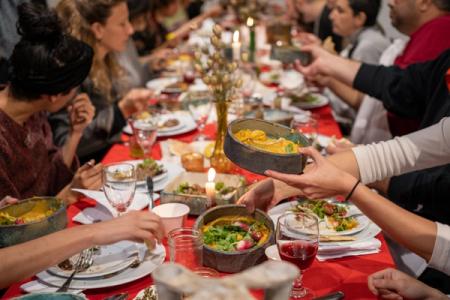
Mirna Bamieh explores the politics of disappearance and memory production by unpacking the social concerns and limitations of Palestinian communities amid contemporary political dilemmas. Since 2019 the artist has also been reflecting on the process of fermentation through text, ceramics and video works incorporated into site-specific interactive installations.
Interview by Luísa Santos